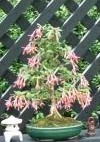 The unique flowers of fuchsias are eye-catching for both their color and distinct teardrop-shape. Most species of Fuchsia are deciduous shrubs or small trees and come from the subtropical areas of South America, Central America, and New Zealand. The plants bloom profusely during the summer and are popular for hanging baskets but can be very attractive bonsai. The best species for bonsai are those with small leaves and flowers, such as F. magalanica, F. minutiflora, F. minimiflora, and F. microphylla, cultivars ‘Tom Thumb’ and ‘Lady Thumb’. F. magalanica is the hardiest and fastest growing of these and may be the best choice for some. Variegated species are generally less vigorous and are best avoided. The best styles for fuchsias are informal upright, semi-cascade, cascade, slanting, and root-over-rock, and in small to medium sizes.
The unique flowers of fuchsias are eye-catching for both their color and distinct teardrop-shape. Most species of Fuchsia are deciduous shrubs or small trees and come from the subtropical areas of South America, Central America, and New Zealand. The plants bloom profusely during the summer and are popular for hanging baskets but can be very attractive bonsai. The best species for bonsai are those with small leaves and flowers, such as F. magalanica, F. minutiflora, F. minimiflora, and F. microphylla, cultivars ‘Tom Thumb’ and ‘Lady Thumb’. F. magalanica is the hardiest and fastest growing of these and may be the best choice for some. Variegated species are generally less vigorous and are best avoided. The best styles for fuchsias are informal upright, semi-cascade, cascade, slanting, and root-over-rock, and in small to medium sizes.
Position: Fuchsias do best during the summer in a light but shaded location, indoors or outdoors. The plants are sensitive to frost so should not be moved outdoors in the spring until after the last frost and should be taken indoors before the first frost in the fall. During the winter plants should be placed in a window at temperatures between 48o and 53o F. Species with small flowers, however, can be kept at temperatures up to 64o F.
Water: Water generously in summer with tap water, sparingly in winter, being careful not to let the roots dry out. When temperatures are high in summer, plants appreciate misting.
Fertilizer: Feed with an organic bonsai fertilizer every two weeks from spring to fall. Do not feed in winter.
Repotting: Repot every two years in the spring, pruning to roots at the same time.
Soil: Bonsai soil or mixture of loam, peat moss, and sand at a ratio of 1:1:1:, with the addition of 1 teaspoon of powdered organic fertilizer
Pruning: Pruning, even of large branches, can be done any time of year to shape the plant and branches should be shortened to one or two pairs of leaves as soon as they are 2-8” long. Weekly pinching in summer is beneficial to reduce leaf size and encouraging branching. Flowers appear on new growth so some new shoots should be left if flowers are desired.
Wiring: Even young branches are inflexible so wiring should be started early and carefully watched so that the wire does not damage the branch. Wiring, however, is usually not necessary because shaping can be done by judicious pruning.
Propagation: Cuttings in mid-spring
Comment: Aphids, whitefly, and greenfly can cause problems.
